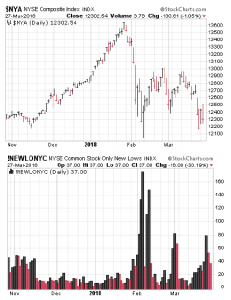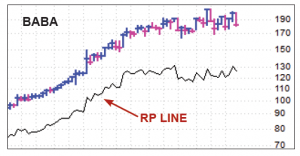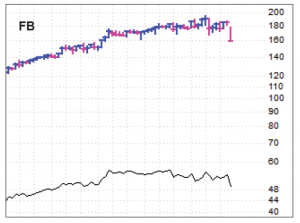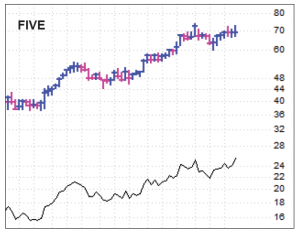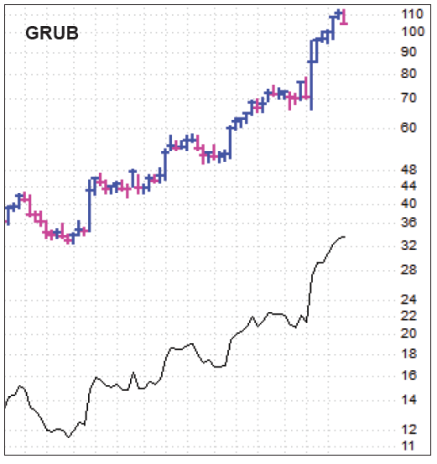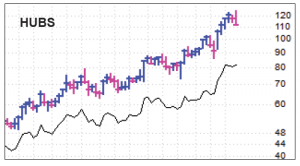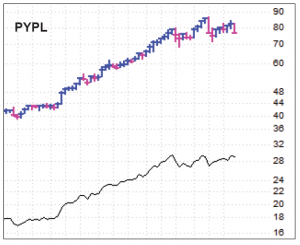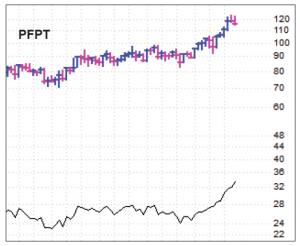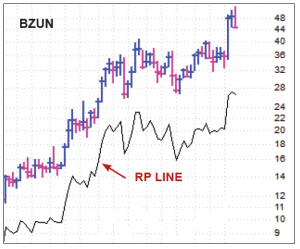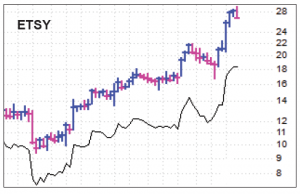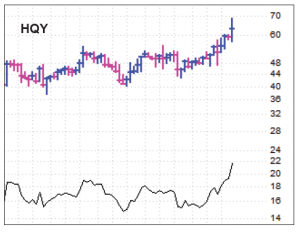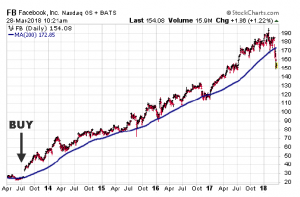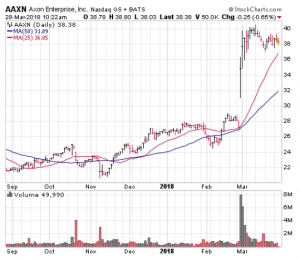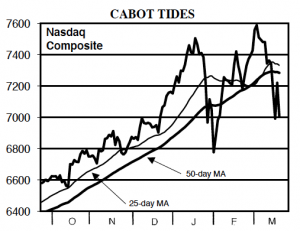The market has taken a turn for the worse during the past week—the February/March rally attempt is over, and now we’re even seeing the sellers come around for growth stocks, which had been resilient. It’s not a time for panic, but we’re taking action, having sold three stocks during the past couple of weeks and, tonight, half of another, leaving the Model Portfolio with around 44% in cash.
Cabot Growth Investor 1390
[premium_html_toc post_id="147292"]
Stay Close to Shore
After a quick, sharp two-week correction in early February, the market embarked on a rally that, on the surface, looked decent—it was enough to flip our Cabot Tides back to positive, and a ton of growth stocks raced up their charts on huge volume.
But the rally was definitely lacking some things. Only one major index reached a new high, there were a couple of whipsaw signals (rarely seen when a market is lifting into a new uptrend) and there was major shrinkage in the number of stocks hitting new highs. Then last week, the rally fell apart.
Where to from here? On the optimistic side, we are seeing some positive divergences in the broad market, something that often occurs near market bottoms. You can see in the charts here that, as the NYSE Composite has been retesting its closing low from February, the number of common stocks (not bonds or preferred stocks) on the NYSE that are hitting new 52-week lows is much less than it was back then. It’s a similar situation on the Nasdaq, too. Other measures, like the action of defensive stocks (we like to look at consumer staples, symbol XLP) don’t show a rush to safety, which is a plus.
But these indicators, while good to monitor, will always be secondary to the action of the indexes and leading stocks. And on that front, there’s not a lot of good news to report. Our Cabot Tides are clearly negative again, and we’re now seeing the sellers start to work on the resilient growth stocks that had been a key underpinning for the market in recent weeks.
All is not lost, as this is still an overall bull market, and many growth stocks actually remain in intermediate-term uptrends. (We’re even seeing some potential new leadership in the retail space, which is something to watch.)
But, simply put, the onus is on the bulls to step up. Until that happens, it’s best to cut back on new buying, honor your stops and hold plenty of cash. One trader used to call this “staying close to shore,” and that’s where we’ll be until the storm passes.
[highlight_box]WHAT TO DO NOW: Be cautious. Given the recent action, we’ve sold our positions in Facebook, Alibaba and ProShares Ultra S&P 500 Fund, and tonight we’re selling half of Shopify, leaving us with around 44% in cash. We have tight stops on a couple other names, but are definitely keeping our Watch List ready for when the buyers retake control.[/highlight_box]
Model Portfolio Update
As the market has been choppy but growth stocks were resilient, we’ve made selective changes to the Model Portfolio. From the market top in late January through last week, we raised our cash level from 20% to 35% by doing a bunch of selling but have also added three stocks. And, coming into this week, the portfolio had given up less than 2% (net) during the two-month slog.
But as the selling pressure intensified further this week, we responded by boosting our cash position to around 44%, including tonight’s partial sale of SHOP.
From here, we’ll simply let the market and our stocks tell us what to do. We’re not eager to raise more cash, per se, but we have mental stops on a couple of stocks and will honor them if the downtrend persists. On the flip side, despite this week’s downturn, we’re still seeing a bunch of potential new leaders if the buyers can retake control.
Current Recommendations
SOLD—Alibaba (BABA 179)—We decided to throw half our remaining shares of Alibaba overboard last Friday as the market and the stock were taking a beating. And we intended to hold our remaining small chunk until it cracked support, but the waterfall decline in growth stocks yesterday caused us to take the rest of our profits off the table on a Special Bulletin yesterday. Long-term, all of the things we’ve written in recent months still apply—BABA looks like a liquid leader in the bull market, with lots of growth ahead and room for investor perception to improve. But with the market in a correction, we looked at our portfolio and saw that this stock was one of our weakest, stuck in a months-long range that showed a good amount of distribution. If BABA eventually gets going, we could always get back in, but right now we think it’s best to book the profit and hold the cash.
SOLD—Facebook (FB 153)—Historically, most big, institutional-quality leading stocks run for between one to two years before topping out, so we were lucky that FB did well for nearly five years from its original breakout in July 2013 (when we bought in). Now, though, we think the tables have turned, as the stock has broken long-term support on huge volume in part due to the data privacy issues that are plaguing the company. Whether this turns into a huge deal is anyone’s guess, but it’s likely this news (along with other factors, such as the expected slower earnings growth going forward) has changed investor perception, which caused us to sell. We’re not predicting a complete meltdown, but our conclusion is that FB is no longer a leading stock. We write more about FB later in this issue.
BUY—Five Below (FIVE 71)—Five Below’s strong, steady growth story continues to play out and the potential is as large as ever. In the fourth quarter, sales (up 30%) and earnings (up 34%) topped expectations, and while the company plans to invest some of its tax cut savings in back-end systems and infrastructure, 2018 looks like another great year. Sales are estimated to rise 19%, partly thanks to 125 new store openings (a 20% hike in the store count), while the bottom line is expected to rise 33%. To be fair, the company does see some tougher comparisons (i.e., slower year-over-year growth) in Q2 and Q3 of this year, but big investors are evidently keeping the big picture in mind (including management’s ultimate goal of 2,500 stores, up from 625 at year-end). Despite the rough market, FIVE’s relative performance (RP) line has nosed out to new peaks ahead of the stock, which bodes well. We’re moving back to Buy, but keep it small if you grab shares.
HOLD—Grubhub (GRUB 99)—GRUB has finally lost some altitude in recent days, though the retreat looks normal; frankly, a dip toward the 50-day line (now nearing 92 and rising) wouldn’t be shocking if the bears dig in. But having already sold half our position a few weeks back, we’re not sweating a near-term decline because we believe the stock’s major uptrend is likely only in the middle innings (the stock didn’t really blast off until last October, just six months ago). While a couple of analysts have downgraded shares based on valuation, earnings estimates (up 41% this year, up 34% next) continue to inch ahead. And any new big deals with restaurant chains could further boost perception. Long story short, we’re holding on tight—some calm trading and a healthier market could provide a solid entry point.
BUY—HubSpot (HUBS 108)—HUBS has dipped sharply to its 50-day line along with many stocks, but the chart doesn’t look too bad, especially considering the stock’s big-volume run in February and early March. One of the big changes that has boosted the company recently has been its embrace of a “freemium” model, attracting more home, small and mid-sized businesses on lower-priced contracts, with the knowledge that customers tend to dramatically increase their usage over time. Indeed, while average subscription revenue per customer fell 4% in Q4 (to around $10,250), the number of subscribers boomed 48% (to 41,600), and there should be more of that coming as smaller businesses open their wallets. Back to the stock, a dip below 102 would call into question the intermediate-term uptrend (and almost certainly coincide with a deeper market retreat), but so far, we think the action is acceptable. If you want to buy a small position (no more than half your normal size, dollar-wise), you can do so here.
HOLD—PayPal (PYPL 75)—There’s been nothing new from PayPal on the news front, and accordingly, the stock remains in a choppy phase with some higher lows (69 in December, 72 in February, 75 in March) but not much net progress since Thanksgiving. As time passes, we see worries over the eBay separation (which isn’t taking effect for a couple of years anyway) fading and big investors refocusing on PayPal’s excellent core fundamentals. A drop below 70 or so would likely have us selling, while a decisive move above 86 would be highly bullish. But right now, with PYPL in the middle of its range, we’ll stay on Hold.
HOLD—Proofpoint (PFPT 112)—PFPT churned a bit in recent days (lots of day-to-day movement with no progress), before sinking sharply on Tuesday. Still, we see as much good as bad in the chart, with shares not that far from new high ground and recent selling volume nowhere near the overwhelming buying volume seen in early March. Thus, we’re optimistic the next major move is up. But with that said, we did buy the stock near the market’s high; given that our Cabot Tides are negative, we don’t want to give our losers too much room. Put it together and we’re switching our rating to Hold and will use a mental stop just below 108, which corresponds to the 10-week line and a 12%-ish loss on our position.
SOLD—ProShares Ultra S&P 500 Fund (SSO 103)—Similar to BABA, we cut our SSO position in half late last week due to the market’s plunge and renewed Tides sell signal, and we sold the rest on a Special Bulletin last evening. Part of the reason for the sale, of course, is the weak market, as owning a leveraged long fund when the sellers are clearly in control isn’t fun. But this wasn’t really a market call—SSO was the worst looking chart among our stocks, and we always gravitate toward selling our weakest positions when the trend is down. Once the bull market resumes (whenever that is), we’re not opposed to adding SSO or a different leveraged long fund (we tend to go with whatever major index is showing the greatest relative strength) to get a foothold in the new upmove. But right now, we thought it best to take the rest of our long-term profits, hold the cash and wait for the storm to pass.
SELL HALF, HOLD THE REST—Shopify (SHOP 122)—SHOP has fallen hard his week after the same short-selling outfit that knocked it back in September spoke up again, this time saying that Facebook’s issues could hurt Shopify’s customer acquisition efforts. As was the case last year, we doubt that this company’s business is going to slow; if anything, we think results can easily top expectations as the small business segment of the economy thrives. That said, there’s no doubt the selling pressures have been intense, with SHOP thrusting below its 50-day line in recent days after a big run since the start of the year. Given that we recently bought a chunk at higher prices, we’re going to cut back tonight, selling half of our total position. The stock’s major trend is still up, but the recent selling means shares likely need some time (and a healthy market) before getting going.
HOLD—Splunk (SPLK 96)—Like everything else, SPLK has taken a sharp hit in recent days, and we’re moving it to Hold because of that. As we’ve written before, the stock’s overall run only began a few months ago (in November), and while there’s nothing that says the stock can correct for a while, it’s unlikely the stock etches a major top here. Also, the fundamentals are pristine. At the company’s Analyst Day this week, management said the company’s addressable market has expanded 13% from last year’s update (to a whopping $62 billion), said it’s introducing apps for business users (instead of focusing mostly on the IT crowd) and reaffirmed its $2 billion revenue target for 2020 (25% annual growth this year and next) and steady margin improvement, too. The stock caught a couple of upgrades after its presentation, though that didn’t help much given the market’s weakness. Because of all the positives, we want to give SPLK every chance to hold up. However, we also don’t want to let what was a good profit turn into a loss (our cost is near 92). Bottom line, we advise holding on, but we’re using a relatively tight stop in the low 90s.
Watch List
Axon Enterprises (AAXN 38): Formerly named Taser, Axon staged a multi-year breakout in February and has held those gains nicely in recent days. See more later in this issue.
Diamondback Energy (FANG 125): We owned FANG for a brief time before getting out near breakeven in January, but the stock (and some energy peers) has pushed back toward its highs, and the growth story remains compelling.
Floor & Decor (FND 50): FND is a category killer in the flooring business, offering better selection and lower prices via its warehouse-format stores. Comparable sales growth is giant and the store count should rise 20% annually for years. The risk is that the housing market falls apart (doubtful) and that the stock is thinly traded ($34 million per day).
Nutanix (NTNX 48): NTNX took a bit of a hit last week, but has held the vast majority of its stunning post-earnings gains. This has the look of a new institutional favorite (it trades $250 million per day in volume) and reminds us a bit of VMware back when that stock was young and vibrant.
Zillow (Z 53): Z’s pullback thus far looks orderly following a great, persistent breakout earlier this month. The company should be the biggest beneficiary of the mega-shift of real estate broker ad spending moving online.
Other Stocks of Interest
The stocks below may not be followed in Cabot Growth Investor on a regular basis. They’re intended to present you with ideas for additional investment beyond the Model Portfolio. For our current ratings on these stocks, see Updates on Other Stocks of Interest on the subscriber website or email mike@cabotwealth.com.
Baozun (BZUN 44) — Unlike retailers like Alibaba and JD.com, Baozun is a Chinese company that works for foreign brands, offering a different approach to Chinese e-commerce. Baozun calls itself a “brand partner,” and the company supports its clients products with services ranging from direct sales to consumers to managing T-Mall and JD.com web content and from social media exposure to strategic help with websites. The company supports every imaginable kind of merchandise, and business has been great, with revenue up 23% in 2017 and earnings more than doubling from 2016 levels. After building a six-month base under resistance at 40 from September 2017, BZUN gapped up on huge volume on March 6 after an earnings report that featured a 31% jump in revenue and a 133% bounce in earnings. It’s a good story.
Etsy (ETSY 28) — Etsy is the antidote to the mass-produced world, a website devoted to bringing creative entrepreneurs and their unique, homemade products and interested buyers together. Etsy boasts 1.9 million active sellers (mostly one-person shops) and 33.4 million active buyers and over 50 million items, making money through listing fees, transaction fees (3.5% per sale), payment processing fees, promoted listings and custom website offerings. Revenue grew by 21% in 2017, a year in which the company also achieved profitability. The appetite for these goods seems enormous, and Etsy’s stock, which had a jagged advance for much of 2017, has morphed into a leader this year thanks to its earnings-inspired surge in February. The stock’s resilience even after a big upmove is encouraging as well.
HealthEquity (HQY 60) — HealthEquity is the largest non-bank custodian of health savings accounts (HSAs), which go along with high-deductible health plans that are becoming more popular. HealthEquity has over two million members who use pre-tax money to pay for medical bills in HSAs, which are the company’s biggest product. The company can integrate its products into existing insurance plans and has been building market share—both in terms of HSA accounts and custodial assets—for years. HQY is hot right now because the company’s Q4 earnings report on March 19 beat estimates with ease, featuring 29% revenue growth and 57% earnings growth, continuing a string of gains that stretches back to 2015. HQY built a long base through 2017, started to rally in December, then blasted off after the earnings report. This is a familiar company with a great, long-term story.
Wix.com (WIX 77) — Wix.com offers small and medium-sized businesses a quick and effective way to build excellent websites without having to do complicated coding. Wix’s Artificial Design Intelligence, Wix Editor and Wix Code offer options from simple to advanced custom sites. The potential audience for this kind of service is huge, and Wix has booked three straight years with revenue growth of 43% or more. 2018 is expected to be the company’s first year of full profitability, and the last two quarters have featured earnings growth of 125% and 129%, respectively. WIX gapped down on big volume in November, but built a solid base and ripped to new highs in February. It’s a bit thinly traded, but it’s a good story and has a nice launching pad to work off of when the market turns healthy.
Fond Farewell to Facebook
After nearly five years, we pulled the plug on our remaining Facebook shares last Tuesday, cutting the cord with one of our longest-held investments of the past few decades. We’ll dive into a deeper study of our trade at a later date, but one thing comes to mind after we gave it some thought this past weekend: A major part of making big money is not just finding big winners, but knowing how to handle them.
After our recommendation in July 2013, Facebook (FB) had (in successive order) corrections of 20%, then 25%, then a period of 10 months of no net progress and little overall movement, then another 19% correction, a 15% correction and another period of no progress, this one for 11 months. And the market had its share of wiggles, too, including the mini-bear phase in 2015-2016 (15% correction) that included an 18-month period of no net progress.
Despite the many retreats, dead periods, and plenty of bad news, we were fortunate to hold onto a core position (though we did take partial profits a few times). Why? By focusing on the chart and following the plan—with big winners, we often use the long-term 200-day moving average as a key line (shown in the chart to the right) in the sand. Indeed, Facebook rode that line almost perfectly for the past few years (we gave it a little extra wiggle room at year-end 2016 because the correction wasn’t that deep), allowing us to ride out the major uptrend.
There are two morals of the story. The first is to think big when you catch a tiger by the tail, because all it takes is one or two big winners to really boost your portfolio. Remember, when you ask yourself how big a profit is enough, the answer is that there’s never enough—you always want to squeeze as much as you can from your best stocks.
Second, once you have a big winner in hand, it’s usually best to be a bit “dumb” and simply trail a loose mental stop. Overanalyzing every new report or rumor isn’t likely to help you hold on for a major move.
This isn’t to suggest we handled Facebook perfectly (we didn’t—some of the partial sales were near lows). There’s always room for improvement! But it was a great run—and now we’re focused on finding the next Facebook.
Phase Two for Taser?
We’ve written before about how leading stocks and companies of the past 15 years have often had more than one life. Netflix is the perfect example, with DVDs-by-mail causing the first rally, streaming causing the second and then original content propelling the third. Apple (iPod, then iPhone, then iPad) and Booking.com (formerly Priceline) are other examples.
We see another possible follow-up winner today. Axon Enterprises (AAXN) was formerly known as Taser, a stock that we rode for monster gains (in a relatively short period) back in 2003-2004. Back then, the firm’s new-age stun guns (the company calls them electrical weapons) looked set to take a huge chunk of the police firearm market, with departments in the U.S. and Europe ordering them in bulk, aiming to avoid unnecessary gun deaths (and lawsuits). Sales and earnings exploded in 2003 and 2004.
But the Taser weapons didn’t catch on as hoped—sales grew slowly for the next few years, and the company actually lost money as recently as 2011. That’s when the top brass went to work expanding its product line.
Taser weapons still make up the majority of revenues (68% of the total in Q4), but growth is slow (10% in Q4). Yet today investors are excited about Axon’s new businesses that are gaining in popularity, including its body cameras, in-car video systems and (importantly) its Evidence.com cloud-based digital evidence management system, which stores all the video from these cameras. And Axon is constantly upgrading the system, boosting search capabilities and allowing uploads of closed-circuit video.
These new video and management solutions are shifting the company more to a recurring (and high margin) cash flow model; already, the firm has licensed Evidence.com to more than 200,000 individual users. The firm’s software and sensor segment grew 27% in Q4; for all of 2018, Axon sees high-teens revenue growth but expanding margins. Analysts see earnings rising 52%.
As for the stock, it’s more thinly traded than we’d prefer, but it soared out of a multi-year base after a great earnings report in February and has held firm during the market’s latest selloff. It’s a bit speculative, but there’s big potential if management continues to execute. WATCH.
Cabot Market Timing Indicators
The market has taken another turn for the worse, this time taking leading growth stocks down with it. There are a few rays of light, but with our Tides and Two-Second Indicator negative and many stocks under pressure, it’s best to play some defense.
Cabot Trend Lines: Bullish
Our Cabot Trend Lines remain bullish. Last Friday, the S&P 500 closed 1.0% below its 35-week line, though the Nasdaq finished 2.4% above its own 35-week line—remember, for a sell signal, we need to see both indexes close two straight weeks below their respective trend lines. Thus, the longer-term trend remains clearly up despite the recent market dip, and we continue to expect the general bull market to resume after this correction ends.
Cabot Tides: Bearish
Our Cabot Tides turned negative late last week, and even the recently resilient indexes like the Nasdaq (daily chart shown here) have moved decisively below their lower (50-day) moving average. You can dive into the chart and claim this was a meaningful double top, or you could say that the index is mostly in a trading range. But we just stick to the system—by our measures, the intermediate-term trend is down until proven otherwise.
Two-Second Indicator: Unhealthy
Our Two-Second Indicator is showing a bit of encouraging action, as the number of new lows during the selling of the past few days has been far fewer than what was seen during the February plunge. (That goes for all new lows, shown here, or just common stocks, shown on page 1.) However, that’s just a first step, and with the number of new lows north of 40 every day, it’s clear the broad market remains unhealthy.
[premium_html_footer]
Send questions or comments to mike@cabotwealth.com.
Cabot Growth Investor • 176 North Street, Post Office Box 2049, Salem, MA 01970 • www.cabotwealth.com
All Cabot Growth Investor’s buy and sell recommendations are made in issues or updates and posted on the Cabot subscribers’ website. Sell recommendations may also be sent to subscribers as special bulletins via email and the recorded telephone hotline. To calculate the performance of the portfolio, Cabot “buys” and “sells” at the midpoint of the high and low prices of the stock on the day following the recommendation. Cabot’s policy is to sell any stock that shows a loss of 20% in a bull market (15% in a bear market) from our original buy price, calculated using the current closing (not intra-day) price. Subscribers should apply loss limits based on their own personal purchase prices.
Charts show both the stock’s recent trading history and its relative performance (RP) line, which shows you how the stock is performing relative to the S&P 500, a broad-based index. In the ideal case, the stock and its RP line advance in unison. Both tools are key in determining whether to hold or sell.
THE NEXT CABOT GROWTH INVESTOR WILL BE PUBLISHED APRIL 11, 2018
We appreciate your feedback on this issue. Follow the link below to complete our subscriber satisfaction survey: Go to: www.surveymonkey.com/marketlettersurvey
Neither Cabot Wealth Network nor our employees are compensated by the companies we recommend. Sources of information are believed to be reliable, but are in no way guaranteed to be complete or without error. Recommendations, opinions or suggestions are given with the understanding that subscribers acting on the information assume all risks. © Cabot Wealth Network. Copying and/or electronic transmission of this report is a violation of U.S. copyright law. For the protection of our subscribers, if copyright laws are violated, the subscription will be terminated. To subscribe or for information on our privacy policy, call 978-745-5532, visit www.cabotwealth.com or write to support@cabotwealth.com.
[/premium_html_footer]

